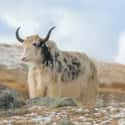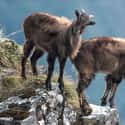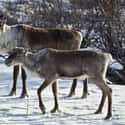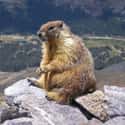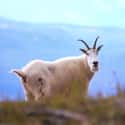-
(#12) Yak
- Bos grunniens
Many people are familiar with the domestic Yak, but there is a wild, undomesticated variety that is native to the Himalayas. These are the ancestors of the domestic Yak, though they remain extant in their native habitat. Yaks are some of the largest bovids found on the planet, and they can weigh as much as 2,646 lbs. (1,200 kg). They are heavily built with a bulky frame, which makes the domesticated Yak ideal for pulling heavy loads.
Yaks are covered in long shaggy hair, which sits atop a dense wooly undercoat over most of the body. This makes it possible for the Yak to survive the harsh cold temperatures of the Himalayas. Several subspecies, including the Wild Golden Yak of China, is listed as "Endangered" due to only 170 known individuals remaining in the wild. Overall, the wild Yak is listed as "Vulnerable" by the IUCN, which noted its population decline as a result of poaching, interbreeding, and cattle-borne disease.
-
(#8) Himalayan Tahr
- Hemitragus jemlahicus
The Himalayan Tahr is a large species of wild goat native to the Himalayas in northern India, southern Tibet, and Nepal. Fortunately, they can survive elsewhere and have been introduced to New Zealand, South Africa, Argentina, and the United States. This is important due to the fact that they are listed as "Near Threatened" by the IUCN. While they aren't considered "Threatened" yet, there is concern that their numbers will begin to fall as global climate change rises.
Himalayan Tahrs are covered in thick, reddish wool coats, which have a thick undercoat, making it easy for the species to survive in harsh cold environments. Their coats begin to thin as winter comes to a close, which helps them adapt as the conditions of their environment become warmer. They can grasp onto sheer mountainous terrain, making it easy for them to avoid predation or capture by humans.
-
(#6) Migratory Woodland Caribou
- Rangifer tarandus caribou
Caribou, or reindeer in many parts of the world, are large species of deer native to the Arctic and sub-Arctic tundra, boreal, and mountainous regions found in Siberia, North America, and northern Europe. Caribou are threatened and listed as "Vulnerable" by the IUCN, which has tracked herds across the world. The caribou of the contiguous United States was declared functionally extinct after its herd was reduced to only three individuals.
Caribou have evolved to adapt to the weather for optimal metabolic efficiency in the warm and cold months of the year. This is due to their ability to store energy for cold months, which is managed by what they eat and how they burn energy finding and consuming food. They consume lichens for their high concentration of carbohydrates to help achieve this, and the further south they wander, the less lichen they are seen eating.
-
(#9) Musk Ox
- Ovibos moschatus
The Muskox (sometimes "musk-ox" or "musk ox") is a species of Bovidae known for its thick coat and strong odor, which is used to attract mates during mating season. They are well known for this smell, but also their unusual look, which the Woods Cree noted in their name for it, which translates into "ugly bison." Muskox can be found in Greenland, Canada, Alaska, and Siberia.
Both the male and females have large, long curved horns ad long, thick fur. Wild muskoxen exist, but the species was domesticated recently. One domestication attempt carried out in the 1950s managed to develop a herd, which is primarily used for meat and wool. Their populations in the wild declined significantly throughout the 20th century due to overheating, though no threats exist for muskoxen in Greenland.
-
(#10) Marmot
- Marmota
Marmots are large ground squirrels found in Asia, Europe, and North America. There are 15 identified species with some living in the Alps, northern Apennines, and Pyrenees mountains. Their preference is a cold and rocky climate, where they make burrowed nests to hibernate in for the winter. The Alpine Marmot is especially fond of cold climates, preferring to nest at heights of 10,500 feet (3,200 m).
They became extinct in the Pyrenees but were successfully reintroduced in 1948, and they continue to thrive there to this day. Due to the climate in which they live, they spend up to nine months out of the year hibernating. When they emerge, they spend most of their time gathering food and eating everything from grasses and herbs to spiders and worms. They aren't fans of warm weather and aren't active very much when the sun is out, even going so far as to forego eating rather than emerge from their burrows on a hot day.
Marmots were in the news in July 2020 after a young boy in Mongolia died after eating one. In doing so, he contracted the Bubonic Plague. Mongolia has recorded nearly 700 cases of Marmot plague between 1928 and 2018. Of those infected, 513 died, leading to a mortality rate of slightly more than 74%
-
(#11) Mountain goat
- Oreamnos americanus
Mountain Goats are a subalpine species of goat found in North America. They are well-known for their ability to cling to sheer rocks in their preferred mountainous terrain. Mountain Goats are predominantly white in color and have significant beards, short tails, and long black horns. Their wooly hide protects them from temperatures as low as −51 °F (−46 °C).
Mountain Goats are the largest animals found in their high-altitude habitats. These can exceed elevations of 13,000 feet (4,000 m), which helps keep them away from predators, though they do sometimes migrate to lower altitudes. While the species has never been domesticated, pre-Columbian Native Americans of the Pacific Northwest Coast incorporated their wool into their weaving. They did this by collecting wool in the Spring, which spared the animals from hunting.
New Random Displays Display All By Ranking
About This Tool
The most representative tundra animals include arctic hares, thunderbirds, polar bears, and grizzly bears, etc. Animals that thrive in the tundra must evolve over time to adapt to the harsh climate and living conditions. The feature of the entire tundra is that there is a permafrost layer under the soil. This cold and humid environment causes physiological drought of plants and a lack of animal diversity.
Tundra is one of the coldest and arid regions in the world, but many very cool and unique animals live in the cold tundra which have evolved unique skills to adapt to survival and hunting. The random tool introduced the 15 coolest animals that live in the tundra.
Our data comes from Ranker, If you want to participate in the ranking of items displayed on this page, please click here.










